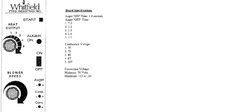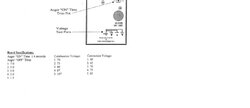Hi Snowy,
On pages 7 and 8 in the service manual for the Advantage II T we actually find some charts with the voltages for the blower motors and the auger intervals. Both generations of control boards are dealt with.
Control panel with rotary knobs:

Newer control panel with touch pads:

If you don't have the service manual I've attached it below this post. There are many useful informations in this manual.
Like Harvey Schneider states... the quality of the meter will influence the reading. In the service manual they are using a high quality Fluke 21 Multimeter. The best way to diagnose the triac output, however, is to use an oscilloscope. A couple of years ago my Quest Plus had a rather annoying whining sound from the convection blower motor. I hooked my handheld scope to the test ports on the panel and made a Youtube clip of it. You can clearly hear the whining on setting 3. Also, we can see that the triac output voltage is ok ( = symmetrical ).
Note: The 10V/Div range must be multiplied by 10, since I'm using a 10:1 voltage divider probe in order to protect the scope input from overload. It can max. handle a 80 V peak-peak signal.
The trigger has some difficulty handling the chopped triac signal, and so does the frequency counter... it interprets the signal to be 100 Hz. The line voltage here is 230 V, 50 Hz, but still a proper diagnose is possible.
[/quote]
Later I found out that these annoying harmonics from the triac-signal are perfectly normal, and that the stove has a built in workaround ( factorymade ). You see, the whining can be tweeked to silence by a trimpot on the rear side of the control board. Now, after a little tweeking, my room blower runs perfectly silent.
Good luck and keep us posted.



